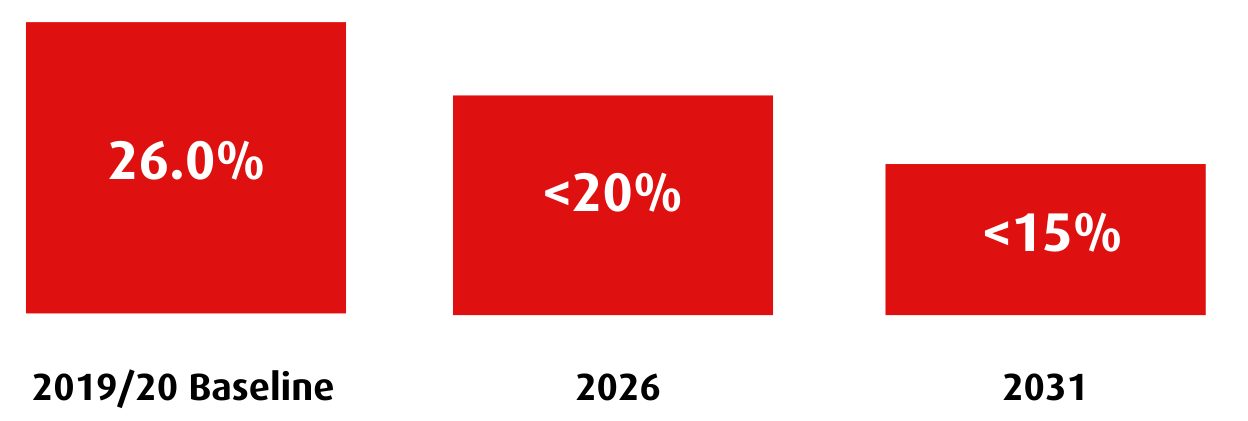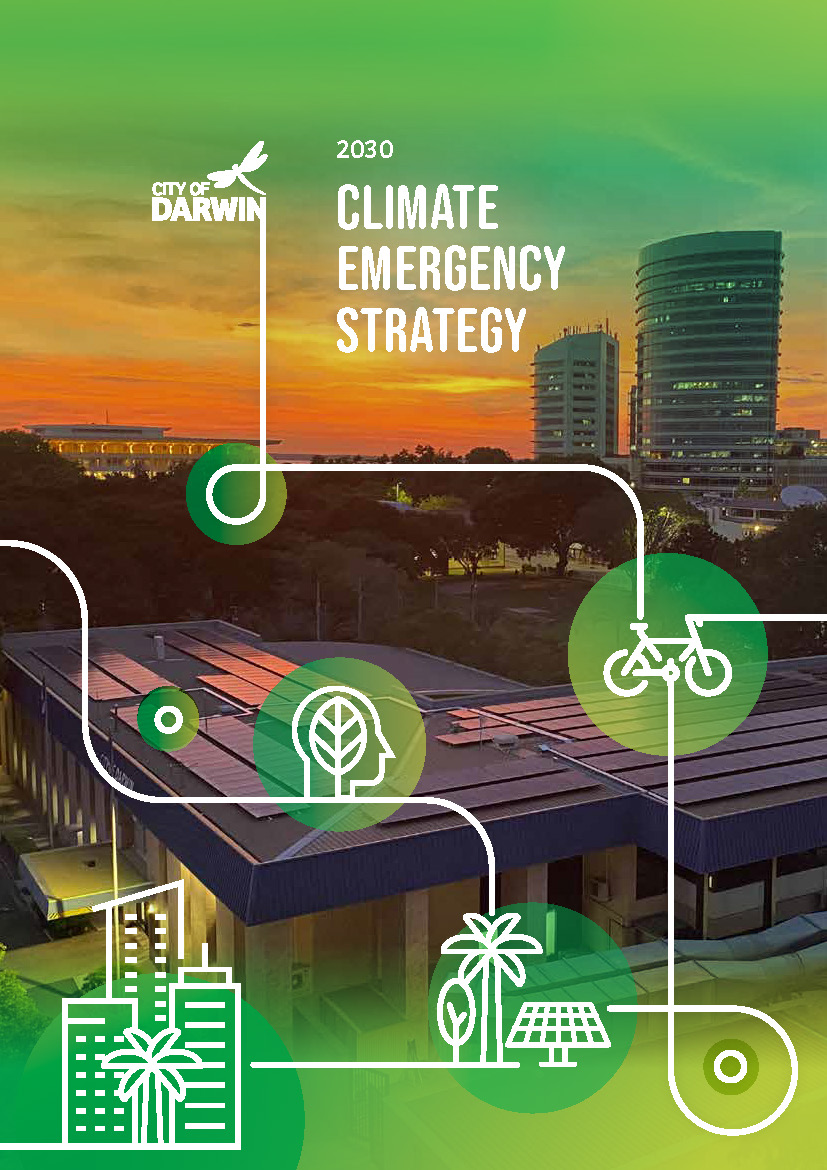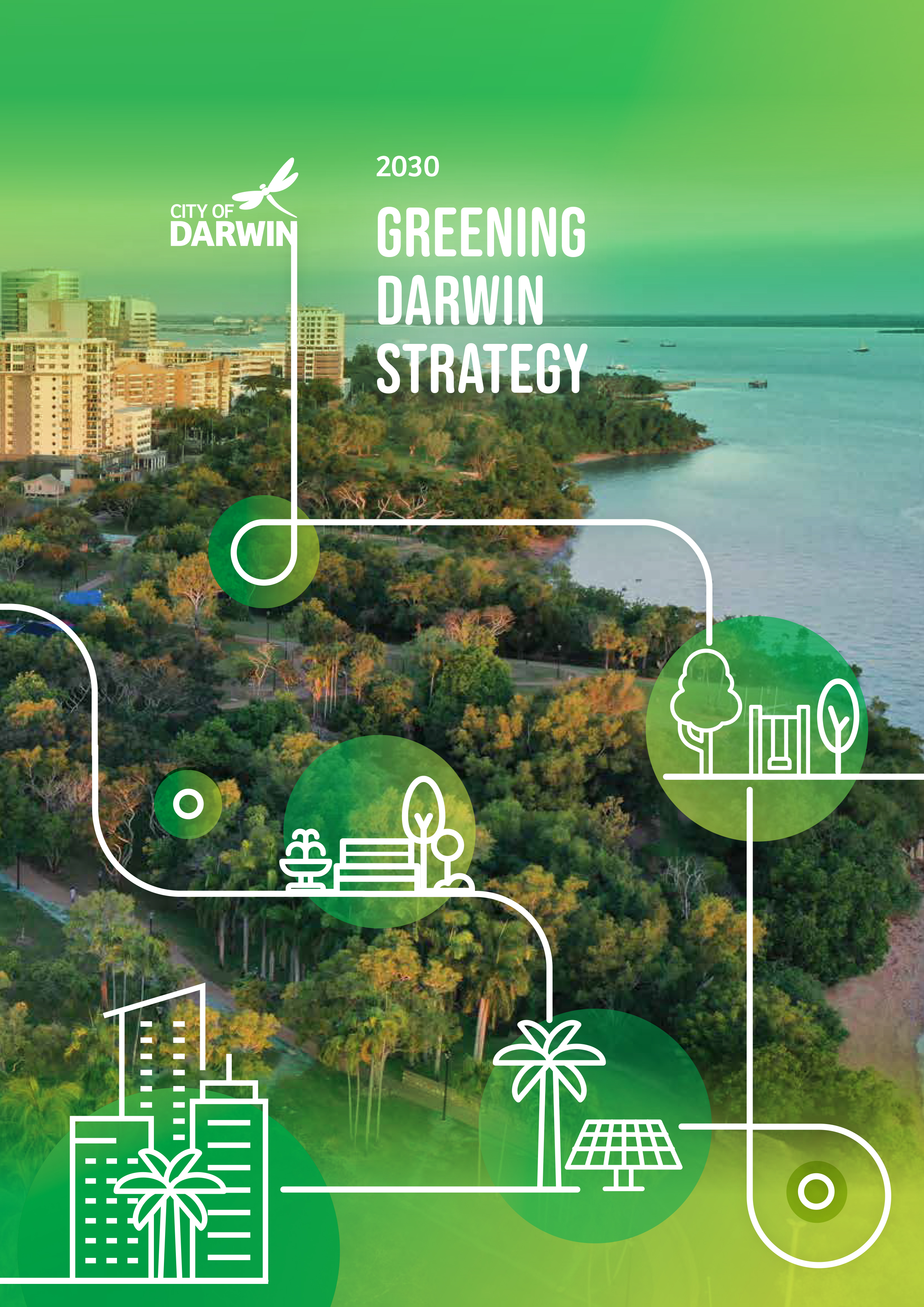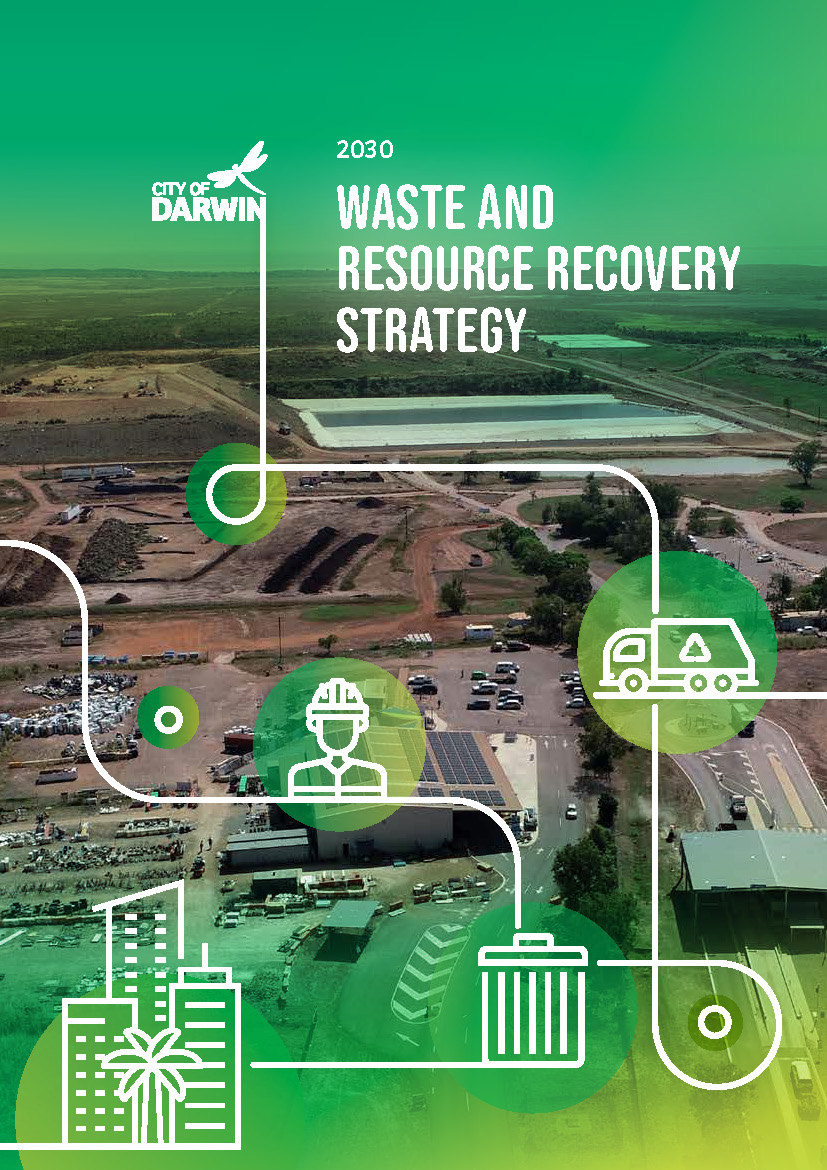Council has put in place three key strategies that will guide the actions and targets Council aims to achieve by 2030 as it strives for a cool, clean and green city.
The strategies are outlined below and through their implementation will deliver on strategic direction 3 as outlined in the 'Darwin 2030 City for People, City of Colour' Strategic Plan.
Click the images above to navigate and view each plan.
Climate Change Emergency Strategy
Climate change is the greatest challenge of our time, and this Climate Emergency Strategy is City of Darwin’s commitment to respond to this issue. By declaring a climate emergency, City of Darwin recognises the urgent need to respond to local changes in the climate and address the socio-cultural, physical, environmental and economic impacts of these changes.
Through this Strategy, City of Darwin will embrace emerging opportunities associated with a net-zero transition that can achieve economic prosperity and improve quality of life while reducing the impacts of climate change.
Net Zero by 2030
City of Darwin is committed to finding practical and effective ways to address climate change concerns within the municipality. This includes managing climate risks to natural and human systems as well as the built environment. By using a combination of sustainable adaptation and mitigation measures we are working towards net-zero greenhouse gas emissions by 2030. For more information about how the City of Darwin is using alternative transport options to help mitigate CO2 emissions, please visit our Movement page.
Renewable Energy - Solar
Renewable Energy and efficiency projects including Solar and Landfill Gas Capture are just some of the projects helping reduce City of Darwin emissions.
City of Darwin has been implementing renewable energy across its facilities since 2010. Sites were prioritised on benefit of installation (including payback period).
Investigation into the potential use of renewable energy for future projects is ongoing. There are a range of small systems throughout the municipality powering lights and other community related infrastructure. Current large systems include:
- Smith Street Mall
- Casuarina Swimming Pool
- Nightcliff Swimming Pool
- Casuarina Library
- Operations Centre
- Civic Centre
- Shoal Bay Waste Management Facility
Co2 Emission Saved (kg) - All Time
Darwin Civic Centre is one of our largest producers of renewable energy and has been producing energy since 2014 as seen in the graph above.
We use on average 79% of solar produced from our panels with the rest getting exported to the grid helping Jacana give our clean energy to other customers!
Equivalent Trees Planted (All Time)
Every Megawatt of power we produce is helping reduce our impact on the environment - since 2013 we have saved so many carbon emissions that it equals us planting over 25,000 trees. That doesn’t mean we aren’t still planting trees we are doing a range of activities to improve our environment and reduce carbon emissions going into the atmosphere.
Greening Darwin Strategy
As part of the City of Darwin’s response to the Climate Change Emergency, in 2021 the City of Darwin adopted a ten-year Greening Strategy. The strategy informs council's way forward in terms of how we manage our urban forest, what trees we plant, and where, how we bolster the environmental values of our urban bushland areas and sets clear targets for us to measure our success against as we deliver on the strategy. Council is currently developing the action plans to ensure we are able to deliver the outcomes of the strategy in the most efficient manner possible, and once those action plans are endorsed, report openly on our performance against those actions over the life of the strategy.
Gardens for Wildlife
Urbanisation is one of the most rapidly expanding forms of man-made change to our landscapes. As our urban habitats change, our local species need to adapt and find new areas to live and breed. The loss of urban biodiversity has both ecological and human/cultural consequences.
Protecting local biodiversity in urbanised areas is challenging. The Greening Darwin Strategy, supports the enhancement and protection of biodiversity and aims to aid in the connection of habitat corridors.
Darwin is fortunate to have significant existing pockets of vegetation such as East Point Reserve, Rapid Creek Reserve, and the Anula Greenbelt. The connectivity between these greenspaces is integral to strengthening of biodiversity within the Darwin municipality and cannot happen without private landowners. Gardens for Wildlife provides support to private landowners in the form of tools and knowledge to collaboratively build the green corridors linking our parks and reserves.
The growing numbers of Gardens for Wildlife members help ensure our local wildlife have safe places to live.
Top 10 Suburb (Members)
Aussie Backyard Bird Count
One of the largest citizen science projects in Australia - provides an opportunity for everyone from school children, senior citizens, families and community groups — to become citizen scientists for one week every October. The data collected helps City of Darwin track the health and abundance of birds in our ever-expanding urban environment. The information can be used to look at the distribution of sightings for species of interest, which suburbs have the most observations, which areas could be surveyed better. See what birds you can see in your backyard.
Top Bird Species Sighted
Total Bird Sighting (All Species) by Year
Waste & Resource Recovery Strategy
City of Darwin uses the internationally recognised waste hierarchy to drive actions around waste management. It is based on a resource-efficient economy model that will:
- Significantly reduce or avoid waste and encourage reuse to minimise the use of virgin resources.
- Once waste reduction and reuse opportunities have been exhausted, focus on maximising the recycling of materials that are left using closed-loop recycling.
- Generate low carbon energy from truly residual waste leaving very little waste going to landfill.
Avoid, reuse and recycling have a variety of tangible and measurable environmental benefits compared with landfill disposal. These include energy savings, avoiding greenhouse gas emissions, water savings, avoiding waste and significant reductions in natural resource use, eutrophication of waterways and airborne pollutants.
To understand how we can better manage our waste and increase recycling and diversion away from landfill baseline surveys were required. Two surveys were contracted out one assessing the waste coming into Shoal Bay Waste Management Facility the second assessing what the community is putting in their general waste and recycling bins.
Waste Objectives and Targets
We have set the following objectives and targets. We will measure our success in reaching these objectives using the following performance indicators:
Objective 1: Increase Diversion From Landfill for Kerbside Bin Services

Objective 2: Reduce Contamination of Kerbside Comingled Recycling Bins

2020/2021 Average General Waste Bin Contents (kg)
The average household throws away 13kgs of waste going straight to landfill, even though 15% of the contents could have gone into recycling!
2020/2021 Average Recycle Bin Contents (kg)
Despite best efforts in separating recyclable waste into their yellow top bin, on average 26% of yellow bin contents is contamination by non-recyclable items including food waste, garden organics and even nappies. This contamination means much of the recyclables will end up in landfill.
Shoal Bay Waste Audits
In 2020/21 the City of Darwin undertook disposal-based waste audits at the Shoal Bay Waste Management Facility (SBWMF). As SBWMF is the only operating waste management facility in the Darwin region, the site captures all waste including industrial, household and commercial. City of Darwin works hard to separate and divert as much waste as possible.
Visual and physical audits were undertaken of material sourced from four key SBWMF locations:
- Stage 5 – Commercial & Industrial and Municipal Solid Waste.
- Stage 2 – Construction & Demolition (Inert).
- Commercial Green Waste – Green Organics Processing Area.
- City of Darwin Domestic Transfer Station – loads audited at Stage 5.
- Material Recovery Facilities Contamination – loads audited at Stage 5.
Composition of inbound waste into landfill (tonnes)
As seen in the graph, Commercial and Industrial waste is one of the largest contributors to Shoal Bay Waste Management facility at over 30%. This highlights a great opportunity for City of Darwin to work with local organisations to minimise waste and identify waste streams that can be recycled into other products and saving waste going straight into landfill.
Diverted from Landfill (Tonnes)
City of Darwin aims to reduce the amount of waste going into landfill to ensure longevity of the facility. Many materials are diverted for recycling and repurposing. As seen in the graph above over half of the recycled materials is steel. Improving the recycling of other materials is always being investigated as part of City of Darwin's commitment to a circular economy.



